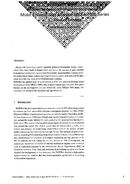PDF
1.22
MB

Motor Exhaust Gas Analyzer MEXA-7000 Series 1. Product Concept
Author: Hideki Ohashi; Juichi Saito
– Along with increasing concern regarding global environmental issues, various efforts have been made to further clean and reduce the amount of gases emitted from internal combustion engines used, for example, in automobiles. Consequently, the measurement items, content and range of emission gases, that must now be measured, have become more diversified and more complex. HORIBA has applied years of achievements and the very lastest technology in the development of the MEXA-7000 series of motor exhaust gas analyzers. This paper focuses on the development concept behind the entire MEXA-7000 series, and introduces its characteristic functions and specifications.
(Same content in Japanese is in Readout No.11-Japanese edition-.)

















